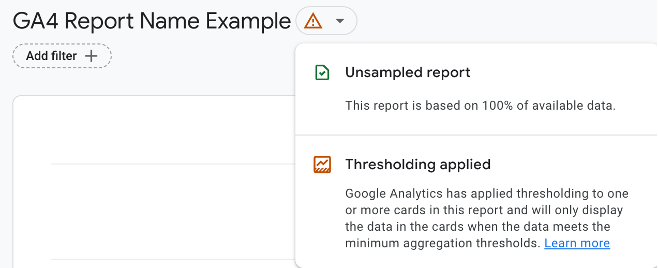
Accurate data is critical to make the right decisions in digital marketing. However, comparing data that has been collected within multiple platforms can lead to discrepancies in reported results. This can be frustrating for marketers because it brings a lot of questions. Why is this happening? Is my data accurate? How do I know which platform to trust? In this blog, we’ll cover the reasons behind discrepancies focusing on the most common platforms and where your source of truth should lie for accurate reporting.
Why Am I Seeing Discrepancies?
There are many reasons as to why you may be seeing variations in your metrics between certain platforms. Here are some of the main factors and considerations to take into account:
Platform-level Factors & Limitations
First and foremost, you should ensure that the data you are viewing shares the same criteria – comparing apples with apples. Check things such as:
- Are the date ranges the same?
- Have you got any filters/segments applied?
- Are the metrics you are comparing calculated in the same manner?
Whilst some of these may seem obvious, they should always be your first step. Data lists within CRM platforms, such as HubSpot, may be filtered to only include specific users and you should therefore ensure that comparative platforms, such as Google Analytics, are also filtered in the same way where possible.
Additionally, platforms may use differing criteria or calculations for specific metrics. For example, HubSpot sessions begin when a visitor returns to your site after 30 minutes of inactivity or from a different traffic source, whereas GA4 does not create a new session when the traffic source changes mid-session, and therefore they are unlikely to display the same session count.
Read more on why HubSpot and Google Analytics data may not match.
GA4 may also withhold data at times, in an attempt to prevent individuals being identified from datasets which are too granular – otherwise known as data thresholding. Having thresholding applied to your data may further increase the levels of discrepancies. Look out for the orange triangle symbol within your reports, which will show you when thresholding is being applied within GA4:

All platforms, such as Google Analytics, Facebook/LinkedIn/Google Ads, HubSpot etc. contain a degree of customisability when viewing your data and can also handle similarly named metrics differently – so these are some important factors to check across the board.
Cookies
User consent to being tracked is a requirement in many countries and - if your website’s consent mechanism is correctly set up - can be another contributor to discrepancies.
Declining analytical cookies would typically result in Google Analytics not being able to collect data in most scenarios, whereas websites hosted by certain CRM platforms may still continue this collection of data. HubSpot hosted websites, for example, will continue to collect data anonymously even after cookies are rejected, creating a new session for each pageview.
Consider a user who visits your website via Google Ads and declines analytical cookies, but consents to advertisement cookies. If the user converts in this scenario, Google Analytics will likely show no data for this conversion journey, whilst HubSpot will report multiple sessions alongside the conversion, and Google Ads will capture 1 click with a conversion.
A properly configured cookie consent set-up on your website should withhold/fire cookies for all external platforms, which can impact your ability to track/collect data, and therefore this should be taken into consideration when discrepancies are found.
Attribution

Arguably one of the most prominent causes of discrepancies between platforms, it is crucial to understand how specific platforms differ in attribution methods.
GA4, by default, utilises a data-driven attribution model. This is where the conversion credit is assigned to the path(s) that Google believes is/are the most beneficial piece to the puzzle, based upon historic data. Furthermore, specific reports within GA4, such as the User and Traffic Acquisition Reports, will use differing attribution methods, such as first user click.
Comparatively, other platforms may vary in their used attribution models i.e., Google Ads allows you to select your desired attribution method on a per-conversion basis. Attribution can also intertwine with cookies - for example, a user clearing their cookies would alter what a platform may see as their first visit to the site, therefore affecting what channel their activity is assigned to if it uses a first-touch attribution model.
Each platform (and sometimes even specific reports within said platforms) will use varying attribution models. It is therefore important to ensure that each platform is using comparable attribution methods when making comparisons, otherwise your data is bound to differentiate.
UTMs and Parameters
Basic data collection into platforms such as Google Analytics is relatively straightforward – you add the tracking code to your website and pageviews and other events will begin collecting. PPC platforms, such as LinkedIn and Facebook Ads, will be able to accurately show you engagement metrics for your ads, but why would Google Analytics and HubSpot report different numbers for these ad interactions?
Google Analytics relies on UTM parameters to be added to your final URL in order to accurately understand where the traffic is coming from. Similarly, tools such as HubSpot can be set up to automatically add tracking parameters to your ads so that they can report on performance. Any missing parameters, or errors, can therefore result in further discrepancies – for example, if viewing the source/medium of “linkedin / paidsocial” within Google Analytics, you may notice lower metrics than what the LinkedIn interface is reporting, not just due to UTMs, but also as a result of all other factors mentioned above.
Which Platform Should I Believe?
As we have already discussed, there are many reasons as to why data on each platform can vary. The platform you choose will depend on the goal of your analysis. If you’re looking to gauge the interaction/performance of a PPC campaign, use the interface for said platform. If you want to identify your top performing landing pages, Google Analytics will be the best tool for you.
The key is to understand your needs and select a platform you can use as the single source of truth for this specific set of data. When discrepancies occur, you should consider the factors we have discussed and shift your mindset to focus on the trends between the two systems, rather than making direct comparisons. If the trends go in the same direction, your data should be accurate. If they don’t, you should review your tracking and set-up as one of these platforms might have an issue.
Here's a quick list of some platforms and when to use them for data analysis:
- Ads platforms like Google, Facebook, LinkedIn – analyse ad interaction, campaign/keyword/targeting performance
- Google Analytics – analyse where your website traffic came from, how people interacted with your site, and how they converted
- HubSpot and other CRM platforms – analyse lead lifecycle and lead gen revenue, understand behaviour post conversion
- Shopify and other ecommerce platforms – analyse revenue by product and category
Get the Right Insights From Your Data
Innovation Visual combines a team of cross-platform experts, who can help you collect accurate data and make better informed decisions by pulling the right insights from the right platforms. Get in touch with us today to discuss your digital marketing needs or learn more about how we can help you gain valuable insight from your data.









